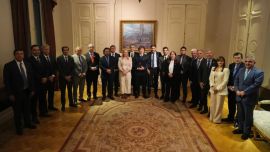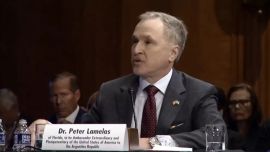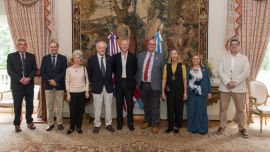With all eyes on Argentina’s presidential election and the country’s ongoing economic turmoil, there’s another area that has faced its own crisis during the Mauricio Macri administration: the environment.
Record yields of soy and a boom in beef sales have been accompanied by the loss of native forests, accelerated soil degradation and growing emissions – the consequence of a model that pins Argentina’s hopes on the limitless growth on agricultural exports.
During Mauricio Macri’s Presidency, the government has slashed, and in many cases completely eliminated, agricultural and mining taxes and export permits. It has enhanced the role of the Agriculture Ministry, while downgrading the environment portfolio. Initially a ministry, it is today a secretariat.
As a consequence, wheat shipments have tripled, soy has performed strongly – bringing in a third of the country’s dollars – and foreign sales of beef hit over half a million tonnes, with China as the main destination. Yet, for many environmental campaigners and activists, the country’s ecosystems have been the ones to pay the price.
The Times talked to a number of environmental experts and organisations in order to assess President Macri’s environmental actions and policies, which have been led by Environment Secretary Sergio Bergman.
All of them agreed that the last four years have been in general terms disappointing, only highlighting the expansion of renewable energy and protected areas of land and ocean as positive aspects of policy. And worryingly, the environment doesn’t look to be much of a priority for a potential government led by Alberto Fernández either.
‘LACKED POLITICAL POWER’
“The environment has been the area with less strength in the [Macri] government, with many of the issues initially proposed not having moved forward,” said Manuel Jaramillo, head of the environmental NGO Vida Silvestre, said. “The area lacked political power.”
Jaramillo’s comments are underlined by just looking at the numbers. This year only 0.08 percent of Argentina’s gross domestic product was allocated to actions related to the environment, much lower than the 0.7 percent recommended by the World Bank, according to an analysis carried out by Fundación Ambiente y Recursos Naturales (FARN).
“Almost all aspects of the way the environment was managed are shameful. The area was first upgraded to a ministry but then downgraded [in 2018 when President Macri reduced the number of ministries in his government], said Gonzalo Strano, an experienced campaigner at Greenpeace. “And it was always headed by someone who didn’t know the first thing about the environment.”
The Times reached out to the Environment Secretariat for comment, but no response was given before this edition went to print.
PRIORITISATION OF AGROINDUSTRY
The advance of the agricultural frontier has had a direct correlation with deforestation in Argentina, which has continued under the current government, now reaching a rate of 150,000 hectares per year, according to official data.
While this is slower than the acceleration registered under previous administrations – at one point it reached 300,000 hectares per year during the Kirchnerite years – deforestation continues to have a devastating and dramatic effect on Argentina.
Today, more than a third of deforestation occurs in native forests, which are notionally protected by the national Forest Law.
“Deforestation is one of the main problematic [issues] in Argentina. Cattle ranching and [the planting of] transgenic soy have expanded to unforeseen levels. There was no public policy to prevent this,” Enrique Viale, the head of the Environmental Lawyers Association, told the Times. “The national government kept blaming the provinces but they also have a role to play.”
Deforestation is a major threat to biodiversity, causing soil erosion, the loss of species and major alterations to the water cycle. More than 80 percent of total deforestation in 2018 occurred in Argentina’s northeast, according to a recent Greenpeace report.
Santiago del Estero, which lost 34,751 hectares of native forest, 23,910 of which were in theory protected, was the worst-hit province, followed closely by Chaco and Formosa.
Since the Forest Law was sanctioned in 2007, it has never received the funding it was supposed to, with the amount dedicated to it in the national budget declining every year, especially as the economic downturn worsened.
Next year, according to the recently proposed budget by the Macri administration, the law will receive only 3.25 percent of the amount it was supposed to receive when the legislation was introduced. This means that in 2020, Argentina will be spending only 10.20 pesos for every hectare of native forest, according to an analysis by FARN.
The expansion of agriculture and cattle linked to deforestation has had a devastating impact on soil. Soy, the main crop grown in Argentina, does not replenish the soil with important nutrients such as nitrogen. As a consequence, the use of chemical fertilisers was widespread, in turn rendering land less healthy and productive.
PROTECTIONS – AND CONTRADICTIONS
However, the Macri administration has taken some positive steps toward protection. Over the last four years, the government has created six new national parks and protected areas.
The new areas, four on land and two covering water and parts of the ocean, means that Argentina now has 493 natural protected areas in total, representing over 10 million hectares. This is highlighted as a major accomplishment by environmental organisations.
Until last year, less than three percent of the country’s marine territory was protected. The only protected oceanic area was Namuncurá/Banco Burdwood, created in 2013. In December 2018, the Senate passed a bill to triple the safeguarded marine territory by creating two new areas: Namuncurá/Banco Burdwood II and Yaganes.
“There are sea lions, some of the biggest penguin rookeries in the hemisphere ... it’s down by the Pacific and the Atlantic oceans and where they crash against each other, so you can imagine the richness and diversity that this area has. It’s very special. It’s unlike any other place on Earth,” said conservationist Kristine Tompkins, praising the shift.
Despite the accomplishment though, environmental organisations highlight a contradiction.
“The main issue on the government’s environmental agenda has been expanding protected areas. But there’s a contradiction. If you expand protected areas, but at the same time you can’t control deforestation, you are facing a serious problem,” Andrés Nápoli, FARN’s executive director, said.
MINING HAZARDS
The mining sector has also benefited during the Macri administration, which has eliminated taxes paid by companies as a way to encourage the activity, reducing tax collection by some US$200 million each year.
Nevertheless, that boost for the companies didn’t mean better standards and environmental protections. For example, the Canadian company Barrick Gold faced three major spills in its Veladero mine in San Juan Province in just 18 months.
The first, in September 2015, led to the spill of one million litres of a cyanide solution in a river near the mine. One year on, a similar accident occurred of smaller proportions. Finally, in 2017, a third spill happened after a pipe that was carrying a chemical substance broke down.
“The government eliminated the taxes for the sector just two months after the first spills. This shows they don’t care about the environment,” Strano alleged. “There has been a clear lack of controls on the mining sector, leading to the spills.”
The spills coincided with the completion of a national inventory of Argentina’s glaciers, which indicated that many mining projects currently under operation, as well as potential projects, are located in areas near glaciers – something technically banned under the country’s Glacier Law.
Seeking to avoid the cancellation of some of its activities, Barrick Gold filed a complaint against the law that reached the Supreme Court. This year the court ruled in favour of the law, declaring it constitutional and, as a result, placing a question mark over the future of several mining projects.
ENERGY – RENEWABLE OR NOT
Renewable energy, mainly solar and wind, saw a big push under the Mauricio Macri administration, booming after years of talk of potential with plenty of contracts put out to tender. But this happened simultaneously with the development and exploitation of Vaca Muerta, a massive unconventional oil and gas reservoir, the exploitation of which has been heavily subsidised by the government.
“There are two energy models at stake. The government chose to simultaneously exploit renewables and fossil fuel energy sources. The question is until when this will be feasible,” Jaramillo said. “The world is asking countries to abandon fossil fuels.”
Renewables at present make up about six percent of Argentina’s energy matrix, thanks to the 49 projects that are currently operational. There are 102 more under construction, which could in theory produce another nine percent of clean energy, closely approaching the country’s goal of a matrix with 20 percent of renewables by 2025.
The sector received a big push from the government with the launch of the RenovAR renewables promotion programme, allocating 4725MW through 185 clean projects. Some have now stalled due to the country’s economic crisis but the sector has clearly taken off. Argentina is embracing renewables like never before.
Nevertheless, the government has been accused of inconsistency, given the simultaneous development of polluting fossil fuel energy, which still represents more than 80 percent of the country’s overall energy matrix and could put Argentina’s climate change commitments in danger.
Vaca Muerta is not only Argentina’s main shale oil and gas formation but also one of the most significant ones in the world, holding 27 billion barrels of oil and 23 billion cubic metres of gas, according to estimates from the United States Department of Energy. Macri specifically targeted its development, granting millions in subsidies to fossil fuel companies over his year in office.
As operations in Vaca Muerta have expanded, so have the number of spills and accidents. According to Neuquén’s environmental agency, between 2015 and 2018, Vaca Muerta saw an average of two spills per day.
“There are almost no environmental controls and the risks are in clear sight. Last year alone Vaca Muerta saw 800 spills. This year an oil rig caught on fire and they couldn’t stop it,” Napoli said. “We keep exploiting fossil fuels when the world goes in the opposite direction.”
CLIMATE EMERGENCY
Putting aside the positives and negatives, the Macri administration has given climate change and environmentalism a higher profile in Argentine political life than ever before.
Back in 2016, the president decided to bring all his Cabinet’s ministers into discussions about climate change, creating a much-publicised Climate Change Cabinet. The idea was that representatives from all government areas would meet regularly to discuss public policies related to the issue.
At the same time, only a few months after taking office, the government decided to review Argentina’s climate change pledge and make it more ambitious. The country is now committed to cut 18 percent of its greenhouse gas emissions by 2030, instead of the initially proposed 15 percent.
Despite that, the current goal is still seen as “highly insufficient” by many climate agencies and not in line with the Paris Agreement, through which countries should work to avoid a temperature increase of two degrees Celsius compared to pre-industrial levels.
Argentina is among the 30 most polluting countries in the world, according to several reports, including Climate Transparency, a global organisation that gathers together scientists, NGOs and their data.
The country generates roughly 0.7 percent of global emissions but when measured per capita the number skyrockets, placing Argentina on a level with some European nations.
The source? The energy industry is the most-polluting sector, with 52.5 percent of the emissions, according to the last inventory. Then, agriculture and land use follow with 39.2 percent. Reducing those numbers will prove difficult with the exploitation of Vaca Muerta and the expansion of agriculture, experts agree.
“Argentina needs to take some tough decisions about how will it reduce further its emissions. This means asking questions about Vaca Muerta, deforestation, transportation and industrial development,” said Jaramillo.
“The government proved to be great at announcements, good at planning the projects – and bad at carrying them out.”
– – –
Argentina’s presidential hopefuls offer little in the way of green issues
The challenges faced by Argentina on the environmental sphere during the Macri administration are likely here to stay. Yet green issues have so far proven to be far down the pecking order of priorities for the presidential hopefuls running in the October 27 election, with many expressing desires to further exploit opportunities out of Vaca Muerta and to increase agriculture activities.
Opposition Peronist hopeful Alberto Fernández, the favourite to win the presidential vote, has expressed his intention of creating a ‘Mining Ministry,’ as part of his goal to significantly increase mining exports over the next few years. He is already working on a plan to offer a set of tax benefits to mining companies in a bid to boost investment.
Fernández has described Vaca Muerta as a “big opportunity” and said oil and gas opportunities have to be further exploited. His advisers are already working on a strategic plan. This would happen with the simultaneous development of renewables, according to the candidate.
The Frente de Todos hopeful has so far only talked about the environment once, at a rally in Salta, a province severely affected by deforestation. He said Argentina had to “take care of its native forests” and said illegal clearing must stop, claiming that “we” should stop “hurting the planet.”
On his electoral platform, Fernández mentioned he would promote an environmental federal pact between the national government and the provinces, seeking a consensus over the best use of natural resources and an agreement over the implementation of best practices.
At the same time, Macri also recently spoke about the environmental agenda for his campaign platform. On his Twitter account, he pledged Argentina would reach the carbon neutrality in 2050, which means the country would remove as much carbon dioxide from the atmosphere as it puts into it. In order to achieve that, he said the country would have to arrive at “zero deforestation” by 2030.
“Argentina has a climate commitment that is currently insufficient to achieve carbon neutrality. To fulfill that objective, deep measures have to be taken such as abandon production and consumption of fossil fuels and stop deforestation linked to agriculture,” FARN countered in its own post on Twitter.


























Comments